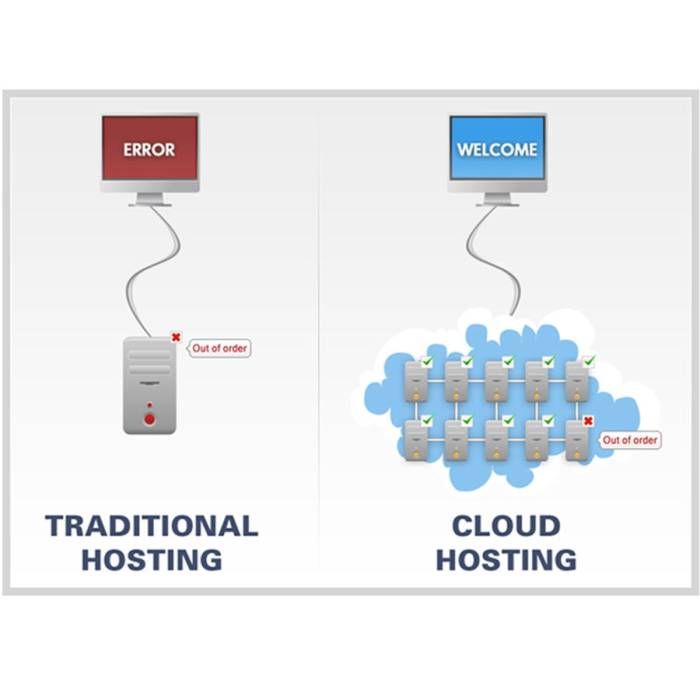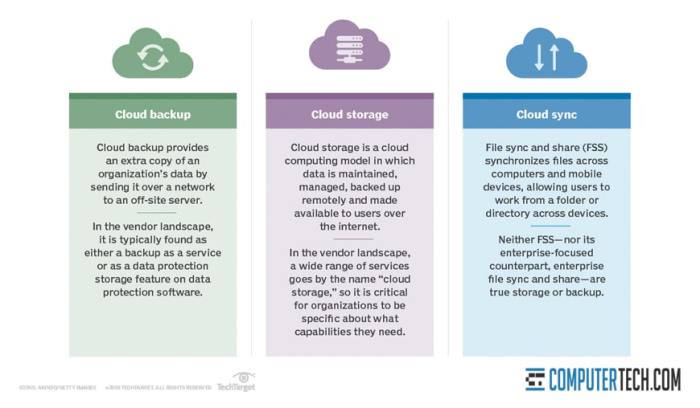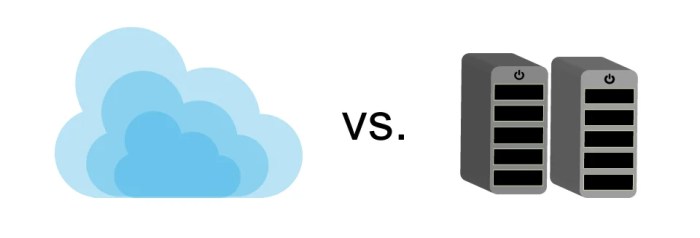Cloud computing vs cloud server: It sounds confusing, right? But think of it like this: cloud computing is the whole shebang – the massive network of servers, storage, and software. A cloud server, on the other hand, is just one piece of that puzzle, a single virtual or physical machine you rent within that network. This deep dive explores the key differences between these two concepts, looking at infrastructure, costs, security, and the various ways businesses leverage them.
We’ll unpack the different types of cloud services (SaaS, PaaS, IaaS), explore the major cloud providers (AWS, Azure, Google Cloud), and even delve into the nitty-gritty of deployment models (public, private, hybrid). By the end, you’ll be able to confidently explain the difference between a cloud server and the broader cloud computing landscape, and maybe even impress your friends with your newfound cloud knowledge.
Defining Cloud Computing and Cloud Servers: Cloud Computing Vs Cloud Server

Okay, so let’s break down these two terms that are often used interchangeably, but are actually quite distinct: cloud computing and cloud servers. Think of it like this: cloud computing is the overall concept, while a cloud server is a specific component within that larger system.Cloud computing is basically the on-demand availability of computer system resources, especially data storage (cloud storage) and computing power, without direct active management by the user.
It’s all about accessing resources over the internet instead of relying on your own physical hardware. The core characteristics defining cloud computing are: on-demand self-service (you can provision resources as needed, without requiring human interaction with each service provider), broad network access (accessible via standard networks and diverse platforms), resource pooling (the provider’s computing resources are pooled to serve multiple consumers, using a multi-tenant model), rapid elasticity (resources can be rapidly and elastically provisioned and released, in some cases automatically), and measured service (resource usage can be monitored, controlled, and reported, providing transparency for billing and optimization).
Cloud Server Definition and Role
A cloud server is a virtual or physical server that’s hosted by a cloud provider and accessed remotely via the internet. It’s a fundamental building block of most cloud computing environments. Essentially, it’s a computer – complete with processing power, memory, storage, and networking capabilities – that you can rent and use without having to buy and maintain the physical hardware.
It acts as the foundation upon which many other cloud services are built. For example, a database might run on a cloud server, or a web application might be deployed to a cluster of cloud servers for scalability.
Comparison of Cloud Server with Other Cloud Services
Let’s compare a cloud server (which is part of IaaS, or Infrastructure as a Service) with other common cloud service models: SaaS (Software as a Service), PaaS (Platform as a Service), and IaaS (Infrastructure as a Service).
| Service Model | Description | Example | Level of Control |
|---|---|---|---|
| SaaS | Software applications delivered over the internet. Users access the software through a web browser or client application. | Gmail, Salesforce, Microsoft 365 | Low – users primarily interact with the application itself. |
| PaaS | Provides a platform for developing, running, and managing applications without the complexity of managing the underlying infrastructure. | Google App Engine, AWS Elastic Beanstalk, Heroku | Medium – users have control over the application and its runtime environment, but not the underlying infrastructure. |
| IaaS (including Cloud Servers) | Provides virtualized computing resources, such as virtual machines (VMs), storage, and networks. Users have the highest level of control over the infrastructure. | Amazon EC2, Google Compute Engine, Microsoft Azure Virtual Machines | High – users have complete control over the operating system, applications, and underlying infrastructure. |
Think of it like building a house: SaaS is like moving into a pre-built apartment; PaaS is like building a house using pre-fabricated components; and IaaS, including cloud servers, is like building the house from the ground up, providing the most flexibility and control, but also requiring the most technical expertise.
Infrastructure and Architecture

Understanding the infrastructure and architecture behind cloud computing and cloud servers is key to grasping their differences. While both leverage computing resources, their underlying structures and how they’re managed differ significantly. This section dives into the specifics of each, highlighting the key architectural components and infrastructure needs.
A cloud computing environment typically employs a distributed architecture, meaning resources are spread across multiple servers and data centers. This architecture allows for scalability, redundancy, and high availability. The interaction between components is complex but can be simplified. Users interact with the cloud through various interfaces (web portals, APIs, etc.). These requests are routed through a load balancer, distributing traffic efficiently across multiple servers.
Virtual machines (VMs), the workhorses of the cloud, run applications and store data. This data is often stored in a distributed storage system, ensuring data durability and availability. Networking is crucial, providing the backbone for communication between VMs and other components. Security measures, such as firewalls and access control lists, are integrated throughout the architecture to protect data and resources.
Cloud Server Infrastructure Requirements
Deploying and managing cloud servers requires careful consideration of hardware, software, and networking. Hardware needs vary based on the server’s intended use, but generally include powerful processors, ample RAM, and substantial storage capacity (often using SSDs for speed). Software requirements include the operating system (e.g., Linux, Windows Server), virtualization software (e.g., VMware vSphere, Hyper-V), and any specific applications the server will run.
Robust networking is vital, encompassing high-bandwidth connections, load balancing, and security features like firewalls and intrusion detection systems. Scalability is a major concern, meaning the infrastructure should be able to easily handle increased workloads. This often involves using auto-scaling features, allowing the cloud provider to automatically add or remove resources based on demand.
Comparison of Cloud Computing and On-Premise Server Infrastructure, Cloud computing vs cloud server
The following table compares key aspects of cloud computing and traditional on-premise server setups:
| Aspect | Cloud Computing | On-Premise Server |
|---|---|---|
| Scalability | Highly scalable; resources can be easily added or removed as needed. For example, Amazon Web Services (AWS) allows for automatic scaling based on real-time demand, adjusting server capacity instantly to handle traffic spikes during peak hours like Black Friday. | Limited scalability; requires significant upfront investment and planning for future growth. Adding capacity often involves purchasing and installing new hardware, a time-consuming and costly process. |
| Cost | Pay-as-you-go model; users only pay for the resources they consume. This can be significantly cheaper than maintaining an on-premise infrastructure, especially for smaller businesses or projects with fluctuating demand. | High upfront capital expenditure for hardware and software, along with ongoing costs for maintenance, power, and cooling. This model often leads to higher total cost of ownership, particularly if resources remain underutilized. |
| Maintenance | Managed by the cloud provider; users are relieved of the burden of hardware and software maintenance. This frees up IT staff to focus on other tasks. | Requires dedicated IT staff for hardware and software maintenance, including patching, updates, and troubleshooting. This can be a significant ongoing expense and requires specialized expertise. |
| Security | Security is shared responsibility between the cloud provider and the user. Cloud providers invest heavily in security infrastructure, but users are responsible for securing their own applications and data. Multi-factor authentication, encryption, and regular security audits are examples of standard practices. | Security is solely the responsibility of the organization. This requires significant investment in security infrastructure and expertise, including firewalls, intrusion detection systems, and security personnel. Compliance with regulations like HIPAA or GDPR is also a major consideration. |
Deployment Models and Service Levels

Choosing the right cloud deployment model and understanding service level agreements (SLAs) are crucial for optimizing your cloud infrastructure. The deployment model dictates where your data resides and how it’s managed, while SLAs define the performance and reliability guarantees your provider offers. These factors directly impact cost, security, and overall application performance.
Cloud Deployment Models
The choice of deployment model significantly influences the security, control, and cost-effectiveness of your cloud solution. Each option offers a unique balance between these factors, making careful consideration essential.
- Public Cloud: Resources are shared across multiple tenants. Think of it like renting an apartment – you get your space, but you share the building’s infrastructure. This is generally the most cost-effective option, offering scalability and easy access. However, you have less control over security and infrastructure configurations. Examples include AWS, Azure, and Google Cloud.
- Private Cloud: Resources are dedicated exclusively to a single organization. It’s like owning your own house – complete control, but significantly higher upfront costs. This model provides enhanced security and compliance, but requires dedicated IT staff to manage the infrastructure. On-premises data centers are a classic example of private clouds.
- Hybrid Cloud: This combines elements of both public and private clouds. Imagine having a main house (private cloud) for sensitive data and a vacation home (public cloud) for less critical workloads. This allows organizations to leverage the benefits of both models, balancing cost, security, and scalability. A company might use a private cloud for sensitive financial data and a public cloud for less critical applications like customer-facing websites.
- Multi-Cloud: This involves using multiple public cloud providers. Think of diversifying your investments – it reduces vendor lock-in and improves resilience. If one provider experiences an outage, you can still rely on others. A company might use AWS for storage, Azure for compute, and Google Cloud for machine learning.
Service Level Agreements (SLAs) and Their Impact
SLAs are contractual agreements outlining the performance and availability guarantees provided by cloud providers. They typically specify metrics like uptime, latency, and recovery time objectives (RTOs). Higher-tier SLAs usually come with a higher price tag but offer greater reliability and performance.For example, a 99.9% uptime SLA means you can expect approximately 8.76 hours of downtime per year. A 99.99% SLA reduces this to about 52 minutes.
This seemingly small difference can be significant for businesses relying on continuous operation. The impact of SLA guarantees varies across deployment models. A private cloud, while offering more control, may not have the same SLA guarantees as a large public cloud provider due to the limited redundancy and scalability built into the infrastructure.
Comparison of Major Cloud Providers
The three major cloud providers – AWS, Azure, and Google Cloud – offer a wide range of server offerings and deployment options. Here’s a simplified comparison:
- AWS (Amazon Web Services): Known for its extensive range of services and global reach. Offers a vast selection of server instances optimized for different workloads, along with robust deployment options across public, private, and hybrid cloud models. Strong in compute, storage, and database services.
- Azure (Microsoft Azure): Integrates well with Microsoft’s ecosystem, making it a popular choice for organizations already using Microsoft products. Offers strong support for hybrid cloud deployments and robust security features. Competitive in compute and storage, with strengths in data analytics and AI.
- Google Cloud Platform (GCP): Known for its advanced analytics and machine learning capabilities. Offers competitive pricing and strong performance in specific areas like big data processing. Provides a range of server instances and deployment options, but its market share is slightly smaller than AWS and Azure.
Security and Management
Securing cloud servers is paramount, as breaches can lead to significant financial losses, reputational damage, and legal repercussions. The shared responsibility model, where the cloud provider secures the underlying infrastructure and the customer secures their applications and data, necessitates a comprehensive understanding of security best practices. This section details key security considerations, provider safeguards, and practical recommendations for securing your cloud server environment.
Data Protection in Cloud Servers
Data protection encompasses various strategies to ensure data confidentiality, integrity, and availability. This includes implementing encryption at rest and in transit, using robust access control mechanisms, and establishing regular data backup and recovery procedures. For instance, encrypting databases at rest using technologies like AES-256 prevents unauthorized access even if the server is compromised. Similarly, using HTTPS for all communication ensures data remains confidential during transmission.
Regular backups to geographically separate locations provide redundancy and business continuity in case of disasters.
Access Control Mechanisms for Cloud Servers
Robust access control is crucial to limit who can access your cloud server resources. This involves using strong passwords, multi-factor authentication (MFA), and implementing the principle of least privilege, granting users only the necessary permissions to perform their tasks. For example, instead of granting a developer full administrative access, provide them with only the permissions required to deploy and manage their applications.
Role-Based Access Control (RBAC) is a common method for managing user permissions effectively. Employing MFA adds an extra layer of security, making it much harder for attackers to gain unauthorized access even if they obtain a password.
Compliance Requirements for Cloud Servers
Meeting industry-specific compliance regulations is critical for many organizations. These regulations, such as HIPAA for healthcare data or PCI DSS for payment card information, dictate specific security controls that must be implemented. Understanding these requirements and choosing a cloud provider that can support your compliance needs is crucial. For example, a healthcare organization needs to ensure their cloud provider complies with HIPAA regulations to avoid penalties for non-compliance.
This might involve data encryption, audit trails, and specific access controls dictated by the regulations.
Security Measures Implemented by Cloud Providers
Cloud providers invest heavily in security infrastructure and practices to protect their customers’ data and servers. These measures include physical security of data centers, network security (firewalls, intrusion detection/prevention systems), regular security audits, and proactive threat monitoring. Many providers also offer features like virtual private clouds (VPCs) to isolate customer environments, and security information and event management (SIEM) tools to detect and respond to security incidents.
For example, AWS utilizes a multi-layered security approach including physical security, network security, and data encryption, along with comprehensive monitoring and incident response capabilities.
Best Practices for Securing Cloud Servers
Implementing robust security practices is vital for minimizing vulnerabilities. This includes regularly patching operating systems and applications to address known vulnerabilities, implementing strong network security measures like firewalls and intrusion detection systems, and employing vulnerability scanning and penetration testing to identify and remediate security weaknesses. Furthermore, regular security audits and employee security awareness training are essential to maintain a strong security posture.
For instance, regular penetration testing can simulate real-world attacks to identify weaknesses before malicious actors exploit them. Keeping software updated prevents attackers from leveraging known vulnerabilities to compromise the system.
So, cloud computing and cloud servers: two sides of the same coin, but with distinct roles. Understanding the differences is key to choosing the right tools for your project or business. Whether you need the massive scalability of cloud computing or the control of a dedicated cloud server, knowing the options empowers you to make informed decisions and optimize your tech strategy.
Ready to dive in and build something awesome?
FAQ Corner
What’s the difference between a virtual and physical cloud server?
A physical cloud server is a dedicated piece of hardware, while a virtual cloud server (VM) is a software-defined server that shares the underlying physical hardware with other VMs. VMs are generally cheaper and more flexible.
How do I choose the right cloud provider?
Consider factors like cost, features, geographic location of data centers, security certifications, and level of support offered. Each provider (AWS, Azure, Google Cloud) has strengths and weaknesses, so research is key.
Is cloud computing secure?
Cloud providers invest heavily in security, but the responsibility for data security is shared. Implementing strong security practices on your end, like using strong passwords and enabling two-factor authentication, is crucial.
What is serverless computing?
Serverless computing is a cloud execution model where the cloud provider dynamically manages the allocation of computing resources. You don’t manage servers directly; you just write and deploy your code, and the provider handles the rest.